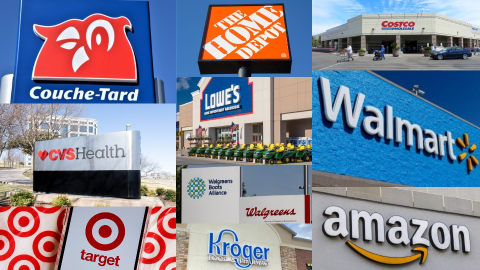The Top 100 Retailers in 2023

If there’s one theme that emerges from our 2023 ranking of top retailers, it’s resiliency. Despite a troubled market plagued by economic pressures that are leading to a mad dash of store closings and layoffs across the industry, retailers are continuing to find ways to thrive.
For the sixth consecutive year, RIS has collaborated with wRatings to rank the industry’s top performing retailers. We’ve highlighted the top 100 companies that are continuing to prosper despite the ongoing volatility, analyzing their percentage of market share and how it translates to overall sales and where these companies are investing to maintain their competitive edge. The Top 10 alone totals $2.4 trillion in sales — besting last year’s $2.3 trillion.
Why the List Looks a Little Different This Year
When comparing this year’s list to last year, we’ve implemented a few changes, which impacted overall rankings when comparing year-over-year. For this year’s rankings, we’ve pulled out all the retailers that were not North America-based. This move eliminated a total of five retailers from the 2023 list, including two which normally make the Top 10: JD.com and Alibaba Group. The five retailers eliminated included four from China and one from Japan because, while these companies all trade on a U.S.-based stock exchange, they don’t operate stores in the country. Additionally, we deleted the restaurant chains category, which is why readers won’t see another historically high ranker — Starbucks, which came in at No. 19 in 2022 — represented in 2023.
The revamp of the list this year was implemented to create a pure retailer list of North American companies. Our hope is that this year’s Top 100 Retailers list more accurately represents our readership.
These changes did not impact the top five retailers on this year’s list, but the removal of JD.com and Alibaba Group left room for home improvement retailer Lowe’s and convenience retailer Alimentation Couche-Tard to step up to the limelight, notching the No. 9 and No. 10 spots of the top 10 retailers.
Below is the full Top 100 Retailers list, as well as a comprehensive look at our top five, and report methodology.
The Top 5 Retailers in 2023
1. Walmart

Walmart once again claims the No.1 spot with a 16.98% retail share of the market, equating to $611 billion in sales. The company wavered in its share of the market in the last few years, but for 2023 it has bounced back, increasing its market share by 4.31% YoY, continuing to beat out Amazon for the lead spot.
In recent months, Walmart store closings have permeated the news cycle; however, this is just a small piece of context of the brand’s larger story: refining its business operations by trimming the fat and investing heavily in digital transformation.
Over the last year, Walmart has been elevating its supply chain efforts, with plans to power 65% of its stores via automation technologies by the end of 2026. The company has particularly focused on fulfillment and distribution, creating what it calls “next-gen centers” that will feature a more agile infrastructure, improved efficiencies, sustainable operations, and a scale back on costly and time-intensive manual efforts. This includes equipping spaces with artificial intelligence-powered tech, robotics, and automation that elevates supply chain storage, retrieval, and merchandise packaging.
Walmart is looking at investments from all digital angles, also putting special emphasis on consumer experiences by improving its e-commerce and app shopping with a product focus and increased personalization capabilities.
It’s an overall holistic approach, according to John Furner, president and CEO of Walmart U.S. who said in a recent call with investors, “it’s becoming more difficult to measure the differences in e-commerce and stores because stores are acting as fulfillment centers at times. So there are a lot of blurred lines between all these channels.”
2. Amazon

While Amazon has had its fair share of concerning blips in the last year, it continues to perform at a top level, laying claim to the No. 2 spot of the Top 100 list. The company makes up a 14.28% share of the retail market, totaling nearly $514 billion in sales. This is a significant bump compared to last year, resulting in an almost $45 million difference in sales from when the company claimed 10.40% of the market in 2022.
Much like Walmart, Amazon has been undergoing a significant shift in its strategic approach, pausing its brick-and-mortar supermarket expansion — with plans to close some Amazon Fresh and Amazon Go physical locations — to refine the plan and meet changing demands.
“We're continuously refining our store formats to find the ones that will resonate with customers, will build our grocery brand, and will allow us to scale meaningfully over time,” said CFO Brian Olsavsky in a statement. This shift followed a flurry of job cuts and Amazon Prime benefit limitations.
The company, however, is throwing investment dollars into other areas of its business, putting a particular emphasis on emerging technology like generative AI. Recent heavy investment into Large Language Models (LLMs) and generative AI is “core to setting Amazon up to invent in every area of our business for many decades to come,” CEO Andy Jassy wrote in a recent letter to investors.
The grocery segment hasn’t been completely forgotten either. Amazon continues to fortify its Whole Foods strategy, recently announcing plans to install Amazon One contactless checkout payment at 11 Colorado locations.
It is also looking to innovate within its supply chain, increasingly leaning on drone-powered delivery and tapping into advanced algorithms and machine learning for fulfillment, with packaging recyclability in mind.
3. CVS Health

CVS Health ranks in the No. 3 spot, owning 8.96% of the market which totals $322 billion in sales. While 2022 saw a small increase in share and sales, CVS has grown substantially for the 2023 ranking, by about $30 billion in sales and up 2.5% in market share.
In the last year, the company has focused heavily on crime prevention, completing (just this month) the installation of time delay safe technology in all 838 CVS Pharmacy locations throughout Florida, including those in Target stores. These safes are helping to prevent pharmacy robberies and potential associated diversion of controlled substance medications like opioids oxycodone and hydrocodone.
The company also strengthened its technological prowess via its acquisition of Signify Health late last year, which gave CVS access to proprietary analytics and technology platforms that support a network of more than 10,000 clinicians across all 50 states to make house calls.
The company’s renewed focus on technology was made even more prominent via the appointment of Tilak Mandadi as CVS’ chief data, digital, and technology officer — a newly created role that oversees the company’s data, digital, and tech strategy. Mandadi now manages the brand’s growth and innovation through digital-led, consumer-focused experiences and services.
4. Costco

In the No. 4 spot is Costco, which owns 6.51% of the market, totaling $234 billion in sales. This is up slightly from last year’s $210 billion in sales.
Costco was recognized several times over the past year, most recently as a top five Most Trustworthy Retailer by Newsweek and Statista. In February of this year, Costco also ranked No. 2 as a top U.S. grocery retailer on the dunnhumby Retailer Preference Index. The company was recognized for its dependability and saving customers money while delivering a seamless experience.
Perhaps one of its biggest claims to fame is its membership, which ranks high among the top loyalty plans in terms of member count. In fact, 28% of the adult U.S. population have Costco memberships, second only to Amazon Prime, according to “The Benefits of Membership: Mass Retailers and Subscription Services,” from PYMNTS.
5. Home Depot

The top five list is rounded out with Home Depot ranking in spot No. 5. Claiming 4.37% of the retail market share, Home Depot garnered $157 billion in sales — up slightly from last year’s $151 billion (a marked improvement after coming in flat from 2021 to 2022).
There’s been significant growth and investment in various areas across the enterprise over the last year. In the workforce space, Home Depot is elevating the associate experience and productivity levels by implementing its machine learning-powered app, Sidekick. The app lets associates know which products are in high demand, which shelves need restocking, and where excess products can be located on overhead shelves.
Also on the labor side of things, Home Depot launched a job seeker marketplace to fill existing gaps by connecting skilled tradespeople with those looking to hire across construction and home improvement.
The company also recently expanded its loyalty program in an effort to increase consumer engagement and retention levels, particularly among its Pro customer base.
"We're always looking for ways to enhance Pro Xtra to best support Pros as their needs grow and evolve, along with their businesses," said Molly Battin, senior vice president and chief marketing officer of Home Depot, in a statement announcing the expanded program. "This tiered loyalty system unlocks a new experience of rewards and savings for our Pro customers with more benefits than ever, right at their fingertips."
Part of connecting with consumers means gaining access to deeper insights, and so The Home Depot also dove deeper into a partnership with Adobe to increase visibility into the customer journey across e-commerce, Home Depot’s mobile app, and in-store services like pickup lockers.
The remainder of the Top 10 includes most of last year’s retail strongholds, including Kroger, Walgreens Boots, and Target. As previously mentioned, Lowe’s and Alimentation Couche-Tard are newcomers to the list compared to last year, raking in 2.7% and 2.57% shares of the retail market, respectively.
Kroger, which has managed several significant enterprise-wide investments over the past year, including a heavy workforce wellbeing lift and a middle-mile transportation overhaul, celebrated $148 billion in sales and a 4.12% share of the market.
Meanwhile, Walgreens Boots ($132 billion) launched a 24-hour, seven-days-a-week, same-day delivery service; Target ($109 billion) launched nationwide drive-up returns and is planning for several supply chain investments; and Lowe’s ($97 billion) is transforming its supply chain by leveraging digital twin technology that fuses spatial data with other data like product location and historical orders to form a complete digital picture.
Methodology
While other lists rank retailers on total revenue, profit, or even share price, this annual list takes a different approach. The retailers that make our Top 100 are ranked on their piece of the total retail market.
Our rankings are based on data gathered from research partner Gary A. Williams, CEO of wRatings. The financial metrics of 180 publicly traded retailers were examined.
The economic data is from a trailing 12-month period ending on March 24, 2023. The percent of retail market share was calculated against a total retail market of around $3.6 trillion. The research ranked North American (including U.S., Canada, Bermuda, Virgin Islands) retailers across apparel, department store, grocery, furniture, beauty, building supply, convenience/fuel, e-commerce, hardlines, and softlines segments.






